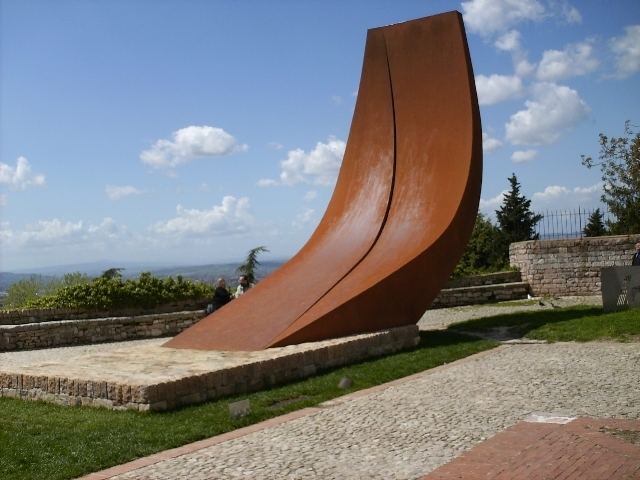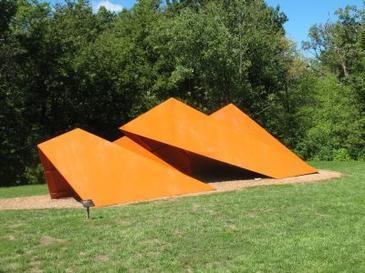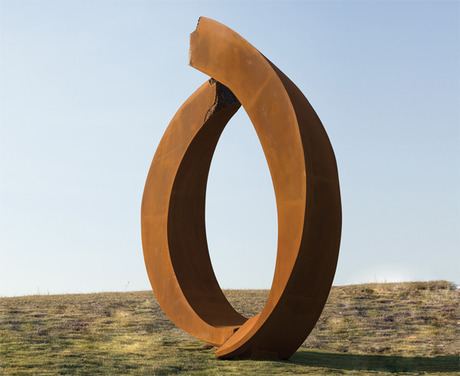Full Name Beverly Stoll Grandchildren Emily Galvin Role Sculptor | Name Beverly Pepper Nationality American Known for Painting, Sculpture | |
 | ||
Children Jorie Graham, John Randolph Pepper Similar People Curtis Bill Pepper, Jorie Graham, Emily Galvin, Peter M Sacks, James Galvin | ||
Beverly Pepper: The Power of Drawings
Who Is Beverly Pepper?
Beverly Pepper (born December 20, 1922) is an American sculptor known for her monumental works, site specific and land art. She remains independent from any particular art movement. She was married to the writer Curtis Bill Pepper.
Contents
- Beverly Pepper The Power of Drawings
- Who Is Beverly Pepper
- Early life and education
- Work
- Exhibitions and collected pieces
- Recognition
- References

Early life and education

Pepper was born Beverly Stoll on December 20, 1922, in Brooklyn, New York. At sixteen, she entered the Pratt Institute in Brooklyn, New York to study advertising design, photography, and industrial design. She then embarked on a career as a commercial art director. She studied at Art Students' League and attended night classes at Brooklyn College, including art theory with György Kepes, who introduced her to the work of Lasló Moholy-Nagy and Man Ray. It was also at this time, in her mid twenties, that she met the environmental artist Frederick Kiesler. Drawn to post-war Europe in 1949, she studied painting in Paris at the Académie de la Grande Chaumière. There she attended classes with cubist painter André L'Hôte, and with Fernand Léger at his atelier. She also visited the studios of Ossip Zadkine and Brâncuși.
Work

Pepper began her career as a painter, but after a trip to Angkor Wat, Cambodia in 1960, she was so awed by the temple ruins surviving beneath the jungle growth that she turned to sculpture. She made her debut in 1962 with an exhibit of carved tree trunks at a gallery in Rome.

Pepper introduces her sculptural vocabulary with integrations of wood carvings and metal castings. Art critic, Rosalind Krauss has described the artist's works as violating modernist traditions... "the traditional craft of carving was closed to her … she attacked these logs with electric drills and saws." After several exhibitions in New York and Rome, she was one of ten artists invited by Giovanni Carandente, along with David Smith, Alexander Calder, Arnaldo Pomodoro, Lynn Chadwick, and Pietro Consagra, to fabricate works in Italsider factories in Italy for an outdoor exhibition, "Sculture nella città", held in Spoleto during the summer of 1962. Working directly in the factory, as she would with subsequent major sculptures, Pepper created The Gift of Icarus, Leda, Spring Landscape, two other large works, and seventeen smaller ones.
As the 1960s progressed, Pepper turned to polished stainless steel. In some of the first works, she used a torch to carve used one-inch thick elements of stainless steel. From there, her pieces evolved into highly polished stainless with painted interiors. They are illusionary works that disappear and reappear, mirroring the surrounding landscape. In an interview with the art historian, Barbara Rose, Pepper said... "Another effect I'm trying to obtain with this bright finish is not simply illusion, but the inclusion of the person looking at it, so that there's a constant exchange going on between the viewer and the work" ..... "My aim here is to invest space with a solidity by filling it with the world around it."
All of Pepper's sculptures from the beginning of her sculptural career were displayed outdoors. Eventually, she began her experiments using earth to contain a sculpture. "In the seventies I developed the concept of "Earthbound Sculptures", that is sculptures seemingly born in or rising up from the earth." Becoming more involved with her native New York in the 1970s, her progressive ideas became realized in commissions such as her seminal work Amphisculpture (1974-76). Furthering her vocabulary in steel, throughout this time period she used Cor-ten steel. While working at a US Steel Factory in Conshohocken, Pennsylvania, she was given Cor-ten steel. Relishing in the exposed rusted surfaces of Cor-ten, she made pieces like Dallas Land Canal (1971-75). She was, in fact, one of the first artists, if not the first, to incorporate Cor-Ten steel into sculpture. Beginning in the 1970s, and to the present day, she has lived a bi-continental life traveling between Europe and the United States.
Later in the 1980s and 1990s, she made works such as Cromlech Glen (restored in 2003), Palengenesis (1993-94) and Sol i Ombra, (1987-92). The works blend nature with industrial materials, as well as inviting the viewer to be a part of the work—"a total environment." Palengenesis exhibits her fascination with cast iron during this period. Barbara Rose explains, "The theme of Palingenesis is of one element born from another, expressed by a sequence of vertical elements that gradually separate from a wall that generates them. The vertical elements progressively become detached from their context as children individualize themselves from a parent. These themes of genesis and continuity are central to Pepper's iconography." In the Barcelona park, Sol I Ombra, the reflective seductive stainless steel of her earlier works have morphed into a fantastic ceramic structure, Cel Caigut. Rose suggests, "Cel Caigut is content–specific as well as site-specific. In an homage to Gaudi, the great turn-of-the-century Catalan architect, Pepper covered the earth mound with shimmering ceramic tile, the material Gaudi used in his famous Park Guell." Recently, Pepper completed another park project for the city of Calgary, Alberta, Canada Calgary Sentinels and Hawk Hill (2008–2010). Pepper says, "I believe my work offers a place for reflection and contemplative thought within the context of active urban environments."
Pepper had her studio in Todi, a hill town in Umbria, Italy.
Exhibitions and collected pieces
Pepper's works have been exhibited and collected by major museums and galleries throughout the world, including:
Recognition
Throughout the years, she has received several awards, including: Doctor of Fine Arts, Alumni Achievement Award and the Legends Award, from the Pratt Institute; Doctor of Fine Arts, The Maryland Institute; Accademico di Merito, University of Perugia; Cittadinanza Onoraria, Todi, Italy: Amic de Barcelona, city of Barcelona, Spain; Chevalier de l'Ordre des Arts et des Lettres, France and The Alexander Calder Prize. Pepper along with Nancy Holt is a recipient of the International Sculpture Center's 2013 Lifetime Achievement in Contemporary Sculpture Award. She was selected as a 1994 honoree for the 1994 Women's Caucus for Art Convention held in NYC.
